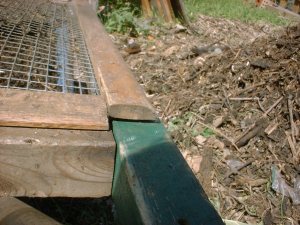 highly speculative and interesting conversation about how and why the Easter Bunny brings eggs and hides them in one’s house. In my childhood household, the Bunny brought eggs with Him or Her and, judging by the dye stains in the sink the next morning, used our kitchen to dye them. He or She then went around our house hiding them in difficult to find places along with baskets containing more colorful eggs and candy. Each basket was labeled with the name of a child. The Bunny seemed to have some general sense of each child’s capacity for hunting and finding based on age.
highly speculative and interesting conversation about how and why the Easter Bunny brings eggs and hides them in one’s house. In my childhood household, the Bunny brought eggs with Him or Her and, judging by the dye stains in the sink the next morning, used our kitchen to dye them. He or She then went around our house hiding them in difficult to find places along with baskets containing more colorful eggs and candy. Each basket was labeled with the name of a child. The Bunny seemed to have some general sense of each child’s capacity for hunting and finding based on age. Who can understand the ineffable mind of the Easter Bunny? What is the relationship between the Bunny, who delivers the eggs, and the Chicken, who creates them? Who cares when you have a pile of chocolate and sugar in front of you after having abstained from both for the past 40 days?
Anyway I digress. You probably tuned in to learn about how to use natural dyes to make beautiful eggs. It’s pretty easy. Start with clean, uncooked white eggs. Put some pots of water on the stove to boil with natural dyes in them. Use about one Tbsp spice or about 1 c of fruit or vegetable and 2Tbsp of white vinegar to 4 cups of water. Make sure the eggs are very clean, then put it in the boiling dye mixture for 15 minutes. Basically, anything that stains fabric or your fingers will dye eggs. If you put more of the dye stuff in the water the eggs will be darker.
Colors
Red or pink: Beets, cranberries or raspberries
Orange: Yellow onion skins or paprika
Yellow: Tumeric
Blue: Blueberries, blackberries, (We tried grape juice but it made the eggs sticky)
Brown: coffee, or tea
Special Effects
Wrap a few rubber bands around the egg before putting it in the water. The part where the rubber band is will stay white and you get a geometric design. Quite nice.
Draw a design on the egg with a wax crayon. If you have little egg dying kit from the drug store there is likely to be a wax crayon in there. You can use it to write a name on the egg.
Wrap the eggs in onion skins and secure with rubber bands. Boil it in plain water for a mottled orange effect, or in with the beet water for a  orange/red egg combo.
orange/red egg combo.
Wrap some interesting dried leaves around the egg and put it in an old nylon stocking. Put it in any of the dyes. The leaves will create a really interesting mottled pattern. This is my favorite method.
A note about dying eggs with someone who is 20 months old. 
She needs a full body bib; her own set of cold water dyes from Paas; hard boiled eggs; glitter and colorful stickers; and a spoon for stirring and dipping and stirring and dipping and stirring and dipping.
Finally More Information about Easter
The name “Easter” originated with the names of an ancient Goddess and God. The Venerable Bede, (672-735 CE.) a Christian scholar, first asserted in his book De Ratione Temporum that Easter was named after Eostre (a.k.a. Eastre). She was the Great Mother Goddess of the Saxon people in Northern Europe. Similarly, the “Teutonic dawn goddess of fertility [was] known variously as Ostare, Ostara, Ostern, Eostra, Eostre, Eostur, Eastra, Eastur, Austron and Ausos.” (From Larry Boemler “Asherah and Easter,” Biblical Archaeology Review, Vol. 18, Number 3, 1992-May/June)
Please post comments, I’m particularly interested in hearing your childhood Easter Egg rituals.










 The Fifteen Hundred Servings project started with the question, “Why are we doing this?” It was July, and we were just getting started with preserving the early harvest of black raspberries. I had read Barbara Kingsolver’s book “Animal, Vegetable, Miracle”, and was acutely aware of the Miracle that is fresh produce. So I started to wonder about what exactly we were trying to accomplish with this preserving. Was it to save money? Somewhat maybe. Was it for health reasons? Probably yes. We think that the food we grow and pick ourselves is healthier than pesticide grown food. Was it fun? Depends on when you ask. Is it satisfying? Definitely yes!! It’s immensely satisfying to grow, harvest, preserve, prepare, serve and eat your own food.
The Fifteen Hundred Servings project started with the question, “Why are we doing this?” It was July, and we were just getting started with preserving the early harvest of black raspberries. I had read Barbara Kingsolver’s book “Animal, Vegetable, Miracle”, and was acutely aware of the Miracle that is fresh produce. So I started to wonder about what exactly we were trying to accomplish with this preserving. Was it to save money? Somewhat maybe. Was it for health reasons? Probably yes. We think that the food we grow and pick ourselves is healthier than pesticide grown food. Was it fun? Depends on when you ask. Is it satisfying? Definitely yes!! It’s immensely satisfying to grow, harvest, preserve, prepare, serve and eat your own food. 



 When we do dig it out in the spring, however, we need something to sift the compost and keep out the sticks, the not-quite-decomposed corn cobs, and other detritus that needs more time in the bin.
When we do dig it out in the spring, however, we need something to sift the compost and keep out the sticks, the not-quite-decomposed corn cobs, and other detritus that needs more time in the bin.  ay the 24″ pieces crosswise between the 47″ pieces. One cross piece goes a couple of inches from the end and the other goes about mid-way along. See the picture above. Then drive nails through the long pieces into the ends of the short pieces to secure them. Next, attach some sturdy L braces on the inside of the corners with wood screws to keep them secure. This thing gets some pretty hard use so you want it nice and sturdy.
ay the 24″ pieces crosswise between the 47″ pieces. One cross piece goes a couple of inches from the end and the other goes about mid-way along. See the picture above. Then drive nails through the long pieces into the ends of the short pieces to secure them. Next, attach some sturdy L braces on the inside of the corners with wood screws to keep them secure. This thing gets some pretty hard use so you want it nice and sturdy. edges where you stapled the screen. When I first built my sifter I didn’t do this and the staples came loose after about twenty minutes of sifting. I just used some scrap trim that was laying around and fastened it with 1-1/2 inch nails. It has held up just fine.
edges where you stapled the screen. When I first built my sifter I didn’t do this and the staples came loose after about twenty minutes of sifting. I just used some scrap trim that was laying around and fastened it with 1-1/2 inch nails. It has held up just fine.